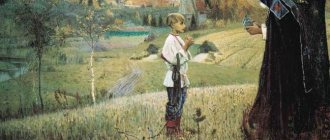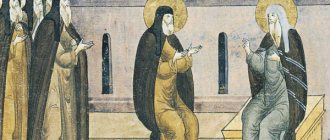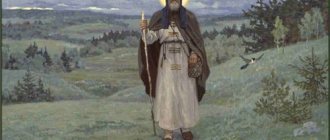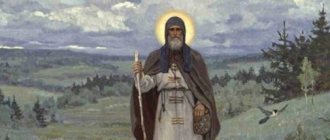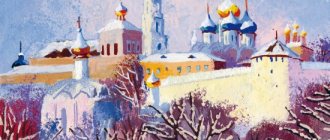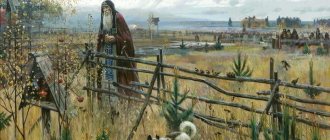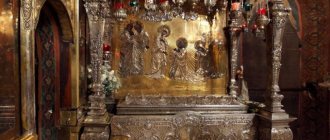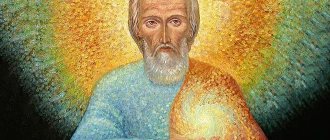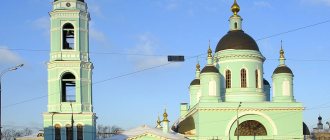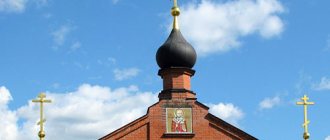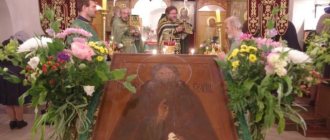Biography and life of Sergius of Radonezh for grades 4, 8
Life of Sergius of Radonezh summary: For 4th grade:
Saint Sergius of Radonezh was born in May 1314. The boy was named Bartholomew. His parents were Kirill and Maria. Besides him, his parents had two more sons. At the age of seven, he began to learn to read and write, but experienced great difficulties. Thanks to prayers and patience, the boy began to study better, even read the Holy Scriptures, fell in love with the church with all his soul, and wanted to become a monk. AND
Because of the Tatars, Bartholomew's father became poor. Around 1330, the parents moved from near Rostov to Radonezh, which was less than 60 km from Moscow. When the eldest sons were already adults and married, Bartholomew's parents became monks. Bartholomew's brother Stephen was widowed and also became a monk. Bartholomew gave his inheritance to his brother Peter, and with Stefan he left Radonezh to live in a deserted place. The brothers built their own housing, then a church. Stefan, due to a difficult life in a deserted place, went to a monastery. In 1337 Bartholomew became monk Sergius. Monks began to come and live with Sergius, and gradually their number grew. The Trinity Monastery was founded. During his difficult, ascetic life, Sergius became abbot in 1354. Sergius himself worked along with the monks. He chopped wood, prepared food, brought water, and instructed the monks. The fame of the monastery spread throughout the area. Many ordinary people and princes came for advice and donated their property. The monastery became rich.
One day Sergius left the monastery when the monks did not like the too strict life. Then he returned at the request of the monks. Before the Battle of Kulikovo, Sergius blessed our troops for victory. He advocated the unification of all Russian lands. In addition to the Holy Trinity Lavra of Sergius, he founded other monasteries. In 1392 the monk died, and in 1452 Sergius of Radonezh was made a saint. His whole life is a feat. For 8th grade:
The work tells the story of the life path of St. Sergius of Radonezh, who was born during the reign of Prince Dmitry of Tver into a family of deeply religious people.
During pregnancy, Sergius's mother often attends church and during one of the church services, the threefold cry of the unborn child is heard from the mother's womb. This incident greatly frightens the pregnant woman and amazes the surrounding church parishioners. The expectant mother, praying to Sergius throughout the entire pregnancy and strictly observing fasts, decides after the birth of the child to devote him to the divine principle. When a boy is born, they call him Bartholomew and at baptism they tell the priest about the cry from his mother’s womb, after which the priest predicts that the boy will serve the Holy Trinity.
Growing up, Bartholomew begins to learn to read and write, but he lags significantly behind his brothers in this activity, worrying and getting upset because of this.
One day, having gone in search of horses on the instructions of his father, Bartholomew meets an old clergyman, who, having learned about the boy’s problem in his studies, gives him a piece of prosphora, thereby promising to correct his gaps in literacy. The boy goes with the elder to the chapel, where the priest sings prayers and asks Bartholomew to read a psalm. Unexpectedly, the boy fulfills the elder’s request, reading the text without errors or errors. After which, looking into Bartholomew’s house, the elder announces to the boy’s parents about his future fate as a great man both in relation to God and in relation to people.
Having matured a little, Bartholomew enthusiastically reads books on the Holy Scriptures, not wanting to communicate with peers, he often attends church, praying fervently and observing all fasts.
Soon the family moves to the Radonezh lands, where they settle not far from the Church of the Nativity. Bartholomew's older brothers get married and start their own families, and the young man asks his parents for blessings for monastic life, but the father and mother bequeath to their son to fulfill his dream after their death. After a while, having accepted monasticism, Bartholomew’s parents leave the sinful earth, and the son, having buried their bodies, honors their memory with Orthodox prayer, distributing alms to the poor.
Bartholomew gives the resulting inheritance to Peter, his younger brother, and his older brother Stephen, who remained a widower, goes to the wasteland, where they create a small church, consecrated by the Kyiv Metropolitan Feongost in the name of the Holy Trinity. After some time, Stefan goes to the Epiphany Monastery, unable to withstand the harsh life in the wilderness, where he acquires the rank of abbot and becomes the prince's confessor.
Bartholomew, with the help of the invited elder Mitrofan, at the age of twenty takes monastic vows, in which he is called Sergius. After the newly minted monk receives communion, the church is filled with extraordinary fragrances.
Sergius's further life is spent in constant church services and prayers, as well as in the fight against the devilish forces trying to instill fear in the monk. At one point, while holding a morning service, the church walls part and an image of the devil appears in the opening, ordering Sergius to leave the wasteland. But the monk was able to cope with demonic power with the help of a cross and a prayer book.
Other monks often visit the wasteland of Sergius and some of them express a desire to live together with Sergius, but he does not allow them to stay with him, since he considers life in the wasteland to be quite difficult and difficult. However, several monks still insist on their choice and settle in the cells adjacent to Sergius, daily engaged in serving God.
Soon the number of monks in the Sergius wasteland reached twelve, but Sergius refused to accept the abbess. He independently makes church candles, makes prosphora and cooks kutya. One day, the elder brother Stefan visits the Holy Trinity Monastery together with his son Ivan, whom he wants to ordain as a monk, and Sergius tonsures his nephew, naming him Feodor.
Some of the monks living in the wasteland do not want to follow the instructions of Sergius and show dissatisfaction. Then Sergius decides to leave the monastery and moves to the Kirzhach River, where he builds a small church and a monastic cell with it. After a while, many monks follow their teacher, while others ask the Metropolitan to return Sergius to the Holy Trinity Monastery.
During one of the services in the monastery, the monks notice next to Sergius a man in shiny clothes, conducting the liturgy with the monk. It turned out that an angel of God helps Sergius in his service.
Six months before his death, Sergius transfers the rights of abbot to his disciple Nikon and at the end of September he dies, spreading a magnificent aroma around his snow-white face.
Biography and life of Sergius of Radonezh for grade 8 Literature report:
Sergius of Radonezh (Bartholomew) (May 3, 1314 - September 25, 1392) - saint, reverend, greatest ascetic of the Russian land, transformer of monasticism in Northern Russia. Born into a boyar family in the village of Varnitsa (near Rostov) to parents Kirill and Maria. Bartholomew had an older brother, Stefan, and a younger brother, Peter. Already in infancy, according to legend, HE refused his mother’s milk on the fast days of Wednesday and Friday. At first, his learning to read and write was very unsuccessful, but then, thanks to patience and work, he managed to familiarize himself with the Holy Scriptures and became addicted to the church and monastic life. In 1328, Sergius's parents, driven to poverty, had to leave Rostov and settled in the city of Radonezh (not far from Moscow). After the death of his parents, Bartholomew went to the Khotkovo-Pokrovsky Monastery, where his elder brother Stefan spent the night. Striving for the strictest monasticism, for living in the wilderness, he did not stay here long and, having convinced Stephen, together with him he founded a hermitage on the banks of the Konchura River, in the middle of the remote Radonezh forest, where he built (c. 1335) a small wooden church in the name of the Holy Trinity, on the site of which now stands a cathedral church also in the name of the Holy Trinity. Soon Stefan left him. Left alone, Bartholomew accepted monasticism in 1337 under the name Sergius.
After two or three years, monks began to flock to him; a monastery was formed, which in 1345 took shape as the Trinity-Sergius Lavra, and Sergius was its second abbot (the first was Mitrofan) and presbyter (from 1354), who set an example for everyone with his humility and hard work. Gradually his fame grew; Everyone began to turn to the monastery, from peasants to princes; many settled next to her and donated their property to her. At first, suffering from the extreme need of everything necessary in the desert, she turned to a rich monastery. The glory of Sergius even reached Constantinople: Patriarch Philotheus of Constantinople sent him a cross, a paramand, a schema and a letter with a special embassy, and with which he praised him for his virtuous life and gave advice to introduce strict communal living in the monastery. On this advice and with the blessing of Metropolitan Alexei, Sergius introduced into the monasteries a communal charter, which was later adopted in many Russian monasteries. Before his death, Metropolitan Alexei, who deeply respected the Radonezh abbot, tried to persuade him to become his successor, but Sergius resolutely refused. According to one contemporary, Sergius “with quiet and meek words” could act on the most hardened and hardened hearts; very often he reconciled the princes warring among themselves, persuading them to obey the Grand Duke of Moscow, thanks to which by the time of the Battle of Kulikovo almost all Russian princes recognized the primacy of Dmitry Ioannovich. Going to this battle, the latter, accompanied by princes, boyars and governors, went to Sergius to pray with him and receive a blessing from him. Blessing him, Sergius predicted victory and salvation from death for him and sent two of his monks - Peresvet and Oslyabya - on the campaign.
Approaching the Don, Dimitri Ioannovich hesitated whether to cross the river or not, and only after receiving an encouraging letter from Sergius, admonishing him to attack the Tatars as soon as possible, did he begin decisive action. After the Battle of Kulikovo, the Grand Duke began to treat the Radonezh abbot with even greater reverence and invited him in 1389 to seal a spiritual testament that legitimized the new order of succession to the throne - from father to eldest son. On September 25, 1392, Sergius died, and 30 years later his relics and clothes were found incorrupt; in 1452 he was canonized. In addition to the Trinity-Sergius Monastery, Sergius founded several more monasteries (Blagoveshchenskaya on Kirzhach, Borisoglebskaya near Rostov, Georgievskaya, Vysotskaya, Golutvinskaya, etc.), and his students founded up to 40 monasteries, mainly in Northern Rus'.
Religious activities
A few years later, a thriving temple of St. Sergius of Radonezh - the Trinity-Sergius Monastery - was formed in this place. Having learned about the establishment of the monastery, Ecumenical Patriarch Philotheus sent the abbot a letter in which he paid tribute to his activities. St. Sergius was a highly respected person in princely circles: he blessed rulers before battles and tried them on among themselves.
In addition to the Trinity-Sergius, during his short biography, Radonezh founded several more monasteries - Borisoglebsky, Blagoveshchensky, Staro-Golutvinsky, Georgievsky, Andronnikova and Simonov, Vysotsky.
The great hieromonk Sergius died on September 25, 1392.
About Fyodor Matveev and his illness
One man named Fyodor Matveev lived not far from the monastery of St. Sergius. And his eyes hurt so much that he did not sleep for many days, day or night. One day in the summer, he led a mule to the field and, exhausted from illness, fell to the ground on his face and mentally asked the wonderworker Sergius to heal him. Lying there, he fell into a light sleep and heard a voice telling him: “Go to the monastery and serve a prayer service to the wonderworker Sergius.”
Then he heard his name called: “Fedor!” - He quickly raised his head, looked and saw with his own eyes a monk sitting on a white horse. The monk drove by and became invisible, and at that time Fyodor’s eyes were healed of the disease. He realized that he had received healing from God through the prayers of the great wonderworker Sergius, went to the monastery of the Most Holy Trinity, to the great helper St. Sergius and served a prayer service, giving glory to God for being healed of the disease through the prayers of the saint.
Interesting Facts
- The Life of Sergius tells that Bartholomew learned to read and write thanks to the blessing of the holy elder.
- Among the students of Sergius of Radonezh were such famous religious figures as Abraham of Galitsky, Pavel Obnorsky, Sergius of Nuromsky, Venerable Andronik, Pachomius of Nerekhta and many others.
- The life of the saint inspired many writers (N. Zernov, N. Kostomarov, L. Charskaya, G. Fedotov, K. Sluchevsky, etc.) to create works of art about his fate and deeds, including a number of books for children. The biography of Sergius of Radonezh is studied by schoolchildren in grades 7-8.
Previous
BiographiesBrief biography of Sholokhov interesting facts and works of Mikhail Alexandrovich
Next
BiographiesDj Groove brief biography of the DJ
About the carpenter, and why the doors of temples are locked from the outside
Once in the church, workers were installing scaffolding for painting the walls. One of them, out of extreme fatigue, lay down to take a nap and fell asleep. Everyone left the church, but they didn’t look for him, and they didn’t even think that he was here, and they locked the western doors of the church (the southern and northern doors were then locked from the inside).
And then a handsome old man approached the sleeping worker and poked him in the ribs; he, waking up, sees an old man standing and says to him: “Go and rest from your labors in a proper place; here, in the holy church, it is proper not to rest, but to say prayers,” and took him from the upper tiers to the church floor. The carpenter, greatly frightened, did not know how to leave the church. The elder led him to the church doors, pointed to the inner bolt and said: “Go out and tell the authorities about everything, without hiding anything.” In fear, he pulled back the bolt and left the church, came to his comrades, but did not dare say anything to anyone.
During the morning service, the sextons, having opened the western doors and entered the church, found that the northern doors were not locked, and when they saw this, they were chilled with fear, believing that there were thieves here. After some time, that carpenter came and told what happened to him, without hiding anything. And from then on all church doors began to be locked from the outside.
